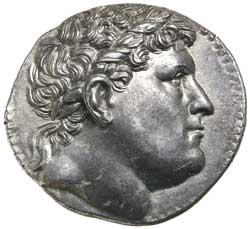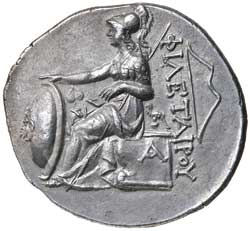Greek Silver & Bronze Coins
Lot 3062 SESSION 7 (9.30AM THURSDAY 30TH JULY) Greek Silver & Bronze Coins
Estimate $4,000
Bid at live.noble.com.au
SOLD $7,000
MYSIA, Pergamon, Kingdom of, Eumenes I, (263-241 B.C.), silver tetradrachm, (16.50 g), Pergamon mint, issued c.263-255 B.C., obv. head of Philetairos to right, laurel-wreath and diadem entwined, dotted border, rev. Athena enthroned to left, supporting shield with ivy leaf under arm, A**Q* monogram on throne, bow and **FILETAIPOU* to right, (S.7218, ACNAC Dewing 2207, SNG Cop.334, BMC 31, SNG Von Aulock 7453, Meydancikkale Hoard 3005). Attractively toned, extremely fine, struck in high relief with a portrait full of character in high relief, rare.
Ex Robert Tonner Collection. Noble Numismatics Sale 111, lot 4527. Ex Decades Collection and Antiqua (Steve Rubinger) on January 18, 2004 from his list (No.55), lot includes ticket and invoice.
Lysimachos entrusted the Pergamene treasury to the eunuch Philetairos, but Philetairos changed his allegiance to Seleukos shortly before the Battle of Korupedion in 281 BC, when Seleukos defeated and killed Lysimachos. Seleukos was assassinated the following year, but Philetairos continued to acknowledge Seleukid suzerainty, as reflected by a series of tetradrachms struck at Pergamon under Philetairos for Antiochos I bearing the portrait of Seleukos I. The Pergamene kingdom enjoyed considerable autonomy under the Seleukids, but in 261 BC, with the encouragement of Ptolemy II, who was at war against the Seleukids, Eumenes I revolted, and defeated Antiochos I in battle near Sardis in Lydia. The remainder of his reign saw an expansion of Pergamene power, including the foundation of a number of cities. Pergamene expansion was always at the expense of the Seleukids, and the two kingdoms remained in opposition. This opposition reached a climax during the reign of Eumenes II, who allied with the Romans during their war against the Seleukid king Antiochos III 'the Great.' This alliance directly contributed to the defeat of the Seleukids at the Battle of Magnesia in 190 BC. In gratitude for his assistance, the Romans gave Eumenes control of Phrygia, Lydia, Lycia, and Pamphylia, and sought to strengthen the Pergamene kingdom as a buffer state between themselves and Seleukids.
The coinage of the Pergamene kingdom is highly conservative, as their tetradrachms employed the same types for the entirety of its existence. The obverse featured the portrait of the founder of the kingdom, Philetairos, and the reverse featuring their patron goddess, Athena. Differentiating the issues of the kings is dependent upon the various subsidiary symbols, monograms, and other details on the coins as noted in Westermark's seminal survey of the kingdom's coinage (with a few later modifications, particularly those noted in the analysis of the Meydancikkale hoard).
Estimate / sale price does not include buyer's premium (currently 22% including GST) which is added to hammer price. All bids are executed on the understanding that the Terms & Conditions of sale have been read and accepted. For information on grading and estimates please refer to the Buying at Auction advice.
Quick find
View a lot by number and sale.
Adjacent lots
Lot 3060
MYSIA, Kyzikos (Cyzicus), silver trihemiobol, (c.480-450 B.C.), (1.09 g), obv. forepart of a running boar, ...
Estimate $80
Lot 3061
MYSIA, Lampsakos, (c.390-330 B.C.), silver trihemiobol, (1.01 g), obv. Janiform female head wearing tainia and ...
Estimate $80
Lot 3062 This lot
MYSIA, Pergamon, Kingdom of, Eumenes I, (263-241 B.C.), silver tetradrachm, (16.50 g), Pergamon mint, issued ...
Estimate $4,000
Lot 3063
CARIA, Pixodaros as satrap, (340-334 B.C.), silver didrachm, (6.95 g), obv. laureate head of Apollo ...
Estimate $1,500
Lot 3064
CARIA, Island of, Rhodes, c.400-385 B.C., silver tetradrachm, (15.04 g), obv. head of Helios three-quarter ...
Estimate $8,000

